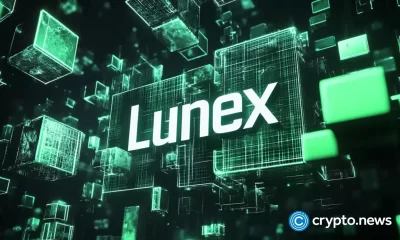Decentralization
Modularity means multiple web3 developer journeys—we only need one
Published
2 months agoon
By
admin
Disclosure: The views and opinions expressed here belong solely to the author and do not represent the views and opinions of crypto.news’ editorial.
Modularity has made significant progress in expanding the web3 developer design space by unbundling the monolithic stack. Yet, with new capabilities comes new challenges that are our duty as protocol builders to overcome.
As the modular ecosystem stands today, there is no single tutorial that guides builders end to end. Developers must take on multiple journeys and educate themselves about every component part before they can start building their dApp. We must create better tools to help them interact with these technologies more productively. The onus is on us to simplify the developer journey, and we must do so by working together.
The modular developer journey
Let’s paint a picture of the current developer journey. Before a developer can start building, they must determine the infrastructure that will support their dApp. In web2, this can be as simple as selecting an operating system or even no-code software tools available online. With monolithic blockchains, it comes down to selecting the layer-1 (or layer-2) that best meets their technical and business requirements. In modular web3, the technical diversity and long-term social unknowns make choosing a protocol an already overwhelming task.
In the modular paradigm, a developer must understand how to construct the blockchain stack one layer at a time. However, many modular solutions are still in highly developmental stages, and it will take time to battle-test them for reliability and long-term relevance.
Additionally, many technical integrations and critical bridges that make modular architecture functional are incomplete or challenging to build with. Most blockchain roadmaps evolve over time; plans and priorities change, and no promises are certain.
This puts an immense cognitive load on developers to educate themselves about the differentiators of countless new protocols, associated security risks, trust assumptions, and overall technical readiness. And even once this is all figured out, there is a lack of shared resources that sufficiently guide developers on how to stack these technologies together.
DApp development is, therefore, high-risk, inconvenient, and very complex in its current form. Until we think more tactically about how these pieces fit together, it will be challenging for any developer to build consumer-friendly products.
We’ve been here before
There are plenty of lessons from the evolution of web2 that can and should be applied to web3. In its earlier phases, developers would run their own servers and might build sophisticated client-server interactions to produce web2-like applications, but it was an arduous and cumbersome process. It wasn’t until significant advances in cloud computing, JavaScript, AJAX, and responsive design that developers had fertile ground to build a web2 capable of achieving mass adoption.
Once the common traits of web2 systems were abstracted away from programmers, it became simple enough for large-scale experimentation. This eventually led to the phenomenal successful consumer applications we see today. This is what we must achieve for web3.
Building on a monolithic chain has edged closer to this state. Take Ethereum (ETH) as an example. Despite its constraints, developers have a clear understanding of how to build a dApp. It created the first true generation of web3 developers who eventually moved on to experiment with other blockchains.
Now, developers’ motivations have evolved past initial curiosity and experimentation, and they want to build sophisticated products that solve problems and create impact. These products require the flexibility and agility of modular solutions to work.
However, this flexibility introduces significantly more complexity. Exponentially, more decisions must be made when composing a modular framework. If we are to enable bolder experimentation and product development in web3, these complexities must be abstracted away in the same way they were in web2.
Building bridges, not islands
As modular protocol builders, we must acknowledge that this is a messy process but one we can systematize. We must create streamlined pathways between protocols and simplify the integration process so that any developer—web3 native or not—can build in easy steps.
There are three primary opportunities where we can collectively begin tackling these challenges.
Cross-platform networks. Core developers from different modular protocols could work together to create shared tools and interfaces that help developers build streamlined products. Developing these shared prototypes that package multiple protocols together will improve the developer experience, as they will be better able to identify the optimal setup according to their dApp’s needs, and seamlessly integrate these elements into their stack.
Shared documentation. Create content, tutorials, and documentation that clearly illustrate how to stack various modular protocols together, express how integrations function, and how one system might complement another. It will help developers better assess their needs, make more educated choices, and ultimately build stronger dApps.
Shared experiment weeks. Coordinate partnered initiatives that bring developers across multiple modular communities together and invite them to experiment and build. This would help developers better understand the dApp-building process across the modular stack, unlock new opportunities for shared development, and catalyze dApp production through experimentation.
The Cambrian explosion of modular solutions means that we see innovation in every corner, but we cannot continue to work in silos. For our protocols to achieve their fullest potential, we must move beyond the competition that consumes our time and energy at each layer and think about how we can collaborate across it. We only succeed when we reach the stage where developers can just focus on building their products, not the infrastructure we have designed to underpin them.

Erick de Moura
Erick de Moura, co-founder of Cartesi, brings over 20 years of software industry expertise, encompassing software business, development processes, and system architecture. Prior to Cartesi, he led teams and projects in diverse sectors, including healthtech, e-commerce, and infrastructure. Currently, Erick serves as a board member and advisor to The Cartesi Foundation.
Source link
You may like


3 cryptos under $0.5 that experts believe could deliver 1500% returns


Gemini’s Cameron Winklevoss Demands Fresh Probe Into SBF


Dogecoin Jumps to 3-Year High Price—Before Bitcoin Cools and Meme Coins Plunge


Crypto cops record $8.2b in financial remedies for investors: SEC


Stellar Price Skyrockets Over 80%, XLM Rally to $1 Imminent?


Elon Musk Tweet of Joe Rogan Profile Sends DOGE Price Higher
Data
Web3’s responsibility is to advance data privacy
Published
1 week agoon
November 16, 2024By
admin

Disclosure: The views and opinions expressed here belong solely to the author and do not represent the views and opinions of crypto.news’ editorial.
In the United States, 92 per cent of individuals reported concern over their privacy while using the internet, highlighting how recent massive data breaches and narratives around Big Tech data monetization have eroded internet users’ trust. This has been especially heightened by the rise of opaque artificial intelligence systems and evolving sociopolitical landscapes.
Gaps in regulation
While the European Union’s General Data Protection Regulation in 2018 set a benchmark as the first comprehensive legal act aimed at enhancing internet users’ privacy rights, it is not without its shortcomings.
GDPR and subsequent regulatory frameworks have largely been ineffective at enforcing and holding Big Tech companies, particularly Google and Meta, accountable for collecting and selling user data. Claims surrounding potential GDPR violations have reportedly taken years, sometimes more than four, to be handled. The delays stem from complex procedures involving multiple agencies and countries handling complaints against specific companies, creating significant backlogs and weakening the act’s ability to enforce and uphold its mandate.
In the United States, the absence of federal legislation on data protection has led numerous states to take matters into their own hands. The US’s patchwork regulatory reality may create more harm than good, as variations on specific matters create endless compliance complexities for businesses operating across numerous states.
Users then receive varying degrees of data protection based on their location at any given time. Furthermore, for small- and medium-sized businesses, developing individual compliance programs for individual state regulators heightens costs that limit their ability to compete with Big Tech and other large corporations.
Meanwhile, Big Tech has been throwing its weight around with intense lobbying efforts, claiming any sort of legislation with real teeth to it will undermine innovation. While this is a discussion worth having, companies whose business model is highly dependent on data-based ad revenue don’t want increased consumer data protections.
Despite heightened awareness surrounding the value and vulnerability of personal data privacy, centralized entities, in the form of Big Tech conglomerates and governments, hold powerful sway over our user data. Regulatory protections are usually welcomed, but the lack of transparency between the intentions of Big Tech and governments won’t repair the distrust many have toward both.
Web3’s heightened role
This is precisely where web3’s decentralized infrastructure can bypass centralized entities, whose interests may not align with most users, to provide a higher standard of data protection.
Blockchain—and web3 more broadly—have had countless iterations and use cases of its technology designed to try and build wealth through games, crypto schemes, or other avenues. However, many projects and developers are either missing or choosing to ignore the potential they have in protecting user data.
Thanks to blockchain’s inherent encryption technology and immutable ledger, some web3-based privacy projects are staking their claim as an alternative to the current web2 system that dominates online interactions to profit from ad revenue. One such example is tomi, a DAO-governed project that leverages web3’s data-preserving strengths to create a decentralized, privacy-focused “alternative internet.”
tomi’s modus operandi is to champion security, data privacy, and freedom of speech throughout its operations and product offering. This includes offering services that advance its mission in material ways—including a VPN, storage, and private messaging service for its users to safeguard their browsing and communications by leaning into web3’s capacity for data privacy. Since the project is governed by a community and works on a unified model to keep the familiarity and UX of web2, tomi’s focus lies in making decentralized technology as intuitive and accessible as possible.
The reality is that as much as regular users would like to take more steps to preserve their data privacy, they’re unlikely to take these measures if there’s any inconvenience involved. This simple fact creates an obstacle that many web3 infrastructure projects don’t feel comfortable trying to overcome.
So, what is the takeaway here? For one, web3 projects must take themselves more seriously as champions of data privacy and protection within a cratered regulatory landscape worldwide. By stepping in with alternatives for those who are concerned about both Big Tech and regulatory overreach, developers have a strong and compelling use case that won’t fizzle out during a market downturn. However, preserving privacy cannot come at the expense of UX, and this must remain at the forefront if projects ever want a significant user base to transition to web3.
Source link
Censorship Resistance
AARON: Ocean’s DATUM Is Tackling Bitcoin’s Most Pressing Problem
Published
2 months agoon
September 30, 2024By
admin

It’s difficult to find a more fundamental threat to Bitcoin’s continued existence than mining centralization. If —say— there are only a few mining pools, there is a very real possibility that these organizations face regulatory pressure of the kind that exchanges have also had to deal with: they could be forced to only include KYC’ed transactions into blocks. Since censorship resistance is arguably its core value proposition, I seriously doubt that Bitcoin would, in this scenario, have much long-term viability at all.
To that end, it was great to see Ocean launch DATUM (Decentralized Alternative Templates for Universal Mining) this weekend. Similar to Stratum V2 (implemented by Demand Pool), DATUM allows miners (or: “hashers”) to select the transactions they include in the blocks they find, while still splitting the block reward with other users of the pool. In other words, hashers get the benefit of pooled mining, without having to outsource transaction selection to the Ocean pool operators, thus making it more difficult to apply regulation. (It’s much easier to regulate a few big businesses —mining pools— in a handful of jurisdictions, than it is to regulate many smaller businesses and individuals —hashers— from around the world.)
Of course, the adversarial mindset will recognize that this doesn’t in itself solve the problem of mining centralization in its entirety. Most obviously, draconian lawmakers could ultimately just ban this type of pooled mining altogether. Besides, it’s not really clear that there is a demand from hashers to construct their own blocks in the first place– though that might of course quickly change if and when there in fact is regulatory pressure that stops pools from including certain transactions in blocks. (And Ocean is providing an incentive for hashers to select their own transactions by cutting fees for those that make use of the new feature.)
Either way, DATUM is an important step in the right direction. If nothing else, it should take away a lot of the concerns of Ocean themselves refusing to include certain “spam” transactions in their blocks: now every hasher can decide for themselves what transactions they do and do not want to include.
The more difficult it is to thwart Bitcoin’s censorship resistance, the brighter Bitcoin’s future looks.
Source link
Adoption
SocialFi, web3, and UX: Cracking the trillion dollar creator economy
Published
3 months agoon
September 10, 2024By
admin
Disclosure: The views and opinions expressed here belong solely to the author and do not represent the views and opinions of crypto.news’ editorial.
SocialFi is a web3 industry attempt at solving the problem of monetizing digital content—the genuine issue affecting millions of talented creators worldwide.
From the perspective of daily users, it might be hard to see creators struggling. However, despite producing quality content daily, the overwhelming majority do not make any money at all. Many SocialFi projects have been launched in the last couple of years, aiming to solve this very monetization part by rewarding every digital interaction for both creators and users. Unfortunately, most seem to have missed the mark by leaning too heavily on aspects of decentralization rather than offering real-world solutions to existing problems.
The origins of mass interest in this space occurred during the pandemic lockdowns. With the idea of pursuing a passion-based career becoming more mainstream, the future of social monetization was catapulted into a new growth phase. This was also a time when the crypto industry saw a mass influx of retail investors, with industry narratives steering towards building pragmatic, real-world solutions. This led to significant advancement in the SocialFi movement, and plenty has been achieved since then in terms of on-chain innovation, tokenized community governance, integration of NFTs, and other DeFi products that authentically bridge issues around creator monetization and user rewards.
Yet, as a sector claiming to be the future of the trillion-dollar creator and freelancer economy, the modest market cap of SocialFi tokens is over $2 billion. This indicates that the sector has a long way to go in establishing itself into a global financial ecosystem. Contrast this with DeFi’s market cap (around $70 billion) or even of NFTs (around $62 billion), and it’s clear that SocialFi has a long road ahead.
Thankfully, there are signs that SocialFi platforms and the utility tokens that power them have a bright future. This is seen in the significant volume of new users willing to join a newly launched SocialFi platform. Sure, many of these users are only there for the free rewards, but that’s the current norm for web3, whether they like it or not.
The benefits of SocialFi
To benefit from such early user traction, builders in SocialFi must be real with themselves when designing a product. The reality is that very few creators care about (or will even benefit from) decentralized content ownership or on-chain proof of IP rights. Although this is a USP widely marketed in web3, it only benefits the top 1% of celebrity creators in the world.
What about the masses? What USP will win their attention and loyalty? The answer to this holds the solution for how SocialFi platforms can finally win market share from Big Tech’s platforms, and central to this is building hybrid ecosystems. This means fusing blockchain features (such as tokenization) with non-blockchain architecture, providing an intuitive and seamless user experience for the masses.
While DeFi and blockchain technologies have a variety of clear benefits and value, mass adoption won’t happen if web2 users are required to get past the web3 wall of creating a digital wallet, store a 20-word seed phrase, and interact with an unfamiliar user experience. If creating an account is harder than starting an Instagram account, you’ve already lost 95% of all potential users. From a user experience standpoint, people cannot be held back by the intimidating web3 gates.
Appealing to the masses
The winners in this space will focus on the narrative that appeals to the masses, building a community of real creators, empowering them with web3 education, and implementing real-world token utility into a seamless user experience. That’s the formula for SocialFi’s success.
Without a doubt, the SocialFi community is tackling these challenges, and 2024 remains a crucial year for projects in this space. The current wave of innovation is the most exciting one, as projects roll out user-centric features that focus on user experience and build upon the value that traditional platforms have already created for the creator community. Tokens matter, but as a secondary driver of growth, and should only exist as a medium to enhance the user experience. This realization will shape the sector moving forward.

Dave Catudal
Dave Catudal, co-founder of Lyvely, is an accomplished entrepreneur in tech and wellness with an extensive background in product innovation and e-commerce. Credited with founding several successful wellness ventures, Dave is building the future of SocialFi at Lyvely, integrating various aspects of web3 to deliver transparent monetization and engagement tools for the creator and freelance economy. Dave previously founded one of the GCC region’s fastest-growing D2C health supplement brands. He also holds a patent for his best-selling fitness machine and online program in the US.
Source link

3 cryptos under $0.5 that experts believe could deliver 1500% returns

Gemini’s Cameron Winklevoss Demands Fresh Probe Into SBF

Dogecoin Jumps to 3-Year High Price—Before Bitcoin Cools and Meme Coins Plunge

Crypto cops record $8.2b in financial remedies for investors: SEC

Stellar Price Skyrockets Over 80%, XLM Rally to $1 Imminent?

Elon Musk Tweet of Joe Rogan Profile Sends DOGE Price Higher

Survival of the healthiest: Creating a successful crypto

Cardano Hydra Unveils Gamified Test Campaign, ADA Price Reacts

The DeFi duo with potential to multiply a crypto portfolio

Bitcoin Rally Benefits From US Buyers

BTC Continues To Soar, Ripple’s XRP Bullish

Ethereum whales accumulate RCO Finance after 2025 predictions hint at a 19,405% rally

US PCE, FOMC Minutes, & Crypto Expiry In Focus, Brace For Market Impact

Cardano Primed To Continue Surging As Whales and Institutions Accumulate ADA, Says Crypto Analyst

Senator Lummis wants to replenish Bitcoin reserves with gold
182267361726451435

Why Did Trump Change His Mind on Bitcoin?

Top Crypto News Headlines of The Week

New U.S. president must bring clarity to crypto regulation, analyst says

Ethereum, Solana touch key levels as Bitcoin spikes

Will XRP Price Defend $0.5 Support If SEC Decides to Appeal?

Bitcoin Open-Source Development Takes The Stage In Nashville

Bitcoin 20% Surge In 3 Weeks Teases Record-Breaking Potential

Ethereum Crash A Buying Opportunity? This Whale Thinks So

Shiba Inu Price Slips 4% as 3500% Burn Rate Surge Fails to Halt Correction

‘Hamster Kombat’ Airdrop Delayed as Pre-Market Trading for Telegram Game Expands

Washington financial watchdog warns of scam involving fake crypto ‘professors’

Citigroup Executive Steps Down To Explore Crypto
Mostbet Güvenilir Mi – Casino Bonus 2024

Bitcoin flashes indicator that often precedes higher prices: CryptoQuant
Trending

 2 months ago
2 months ago182267361726451435

 Donald Trump4 months ago
Donald Trump4 months agoWhy Did Trump Change His Mind on Bitcoin?

 24/7 Cryptocurrency News3 months ago
24/7 Cryptocurrency News3 months agoTop Crypto News Headlines of The Week

 News3 months ago
News3 months agoNew U.S. president must bring clarity to crypto regulation, analyst says

 Bitcoin4 months ago
Bitcoin4 months agoEthereum, Solana touch key levels as Bitcoin spikes

 Price analysis3 months ago
Price analysis3 months agoWill XRP Price Defend $0.5 Support If SEC Decides to Appeal?

 Opinion4 months ago
Opinion4 months agoBitcoin Open-Source Development Takes The Stage In Nashville

 Bitcoin4 months ago
Bitcoin4 months agoBitcoin 20% Surge In 3 Weeks Teases Record-Breaking Potential



